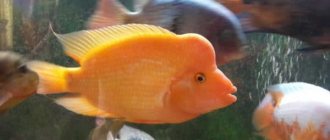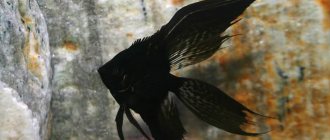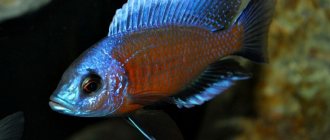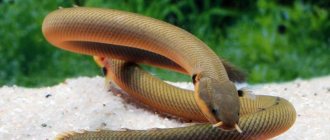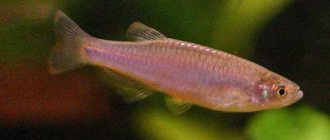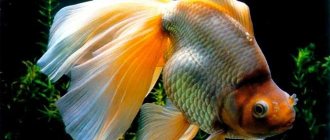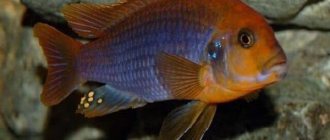Sedzhik's cichlazomas are fish that have neither variegated colors nor unusual sizes, but at the same time they are favorites of aquarists. Why are they so popular?
Cichlosom Sedzhik is also called pink-finned and wine-finned cichlosomas. These fish are native to the calm waters of the rivers of Panama and Costa Rica. They chose small tributaries with numerous natural shelters. Sedzhik's cichlazomas live in Central America from Costa Rica to Colombia.
Appearance
The body of the fish is slightly elongated in length, high, slightly flattened on the sides. The head is quite massive, the eyes are huge, azure blue, and the lips are full. The coloring of females and males is different. In males, the main color is gray with a brown tint, the back is several tones darker, and the abdomen and chest are painted in light colors. The sides are covered with gold; when light is refracted in the scales, they cast a bluish tint.
There are 7 to 9 stripes running across the sides in the transverse direction. The stripe running in the middle always has a more noticeable, rich color. The color of the tail and fins is lilac. When the fish reaches sexual maturity, its tail, anal and dorsal fins acquire a pointed shape.
In addition, males are characterized by the presence of a fatty bump ; during spawning, it swells even more, significantly increasing in size. In females, the base color is gray with a mixture of brown, the scales are turquoise at the base of the fins. The fins are yellow, with a black border running along their edge. Unlike males, the dark lines on the body are more pronounced, becoming even darker and more prominent when spawning begins.
In young animals, sexual differences and nuances in appearance are invisible; it is possible to distinguish a female from a male only during puberty. Representatives of this species reach sexual maturity at approximately 12 months of age. The length of males reaches from 10 to 13 cm, females are smaller - from 5 to 8 cm.
Reproduction by Sedzhik cichlases
Pairs form at approximately 9 months of age. The resulting couple remains inseparable almost all the time. At first, the male shows off in front of the female, opens his fins and touches her while swimming.
Later, the pair begins to look for a place to spawn. The fish dig a nest in different parts of the aquarium until the female chooses a secluded place where she will not be disturbed by other inhabitants of the aquarium. This place will be constantly guarded by the male. In a community aquarium, you can make a nest from a flower pot.
By spawning, the fish become darker in color.
Once a location has been chosen, the pair prepares to spawn. The color becomes much darker, the stripes appear more clearly, in females the fins turn yellow, and the characteristic letter “T” appears. The eyes become bright blue.
The fish clear the place where the laying will take place; they carry all the pebbles out of the house in their mouths. The female climbs into the shelter, and the male guards the territory. Most often, in the morning the female lays 100-400 eggs. The eggs are light orange, about 1 millimeter in diameter. The male fertilizes the laid eggs.
Features of behavior
Cichlazoma Sedzhika is a fish with a peaceful, kind character; it is not inclined to harm its neighbors in the aquarium, who are representatives of another species, and will not spoil plants, trying to dig them up, or aquarium decor items. But during the spawning period, behavior can change dramatically.
Representatives of this species are territorial fish, which, feeling the threat of their territory being seized, can boldly and courageously go to defend it. Cichlaz will not be stopped even by the fact that the enemy can be several times larger than them in size. But we must pay tribute to these brave fish - they will never attack for no reason, their aggressive actions are dictated by self-defense.
Sedzhik cichlazomas go to defend their territory in pairs, which they form during the spawning period.
By making sharp movements with their fins, these small brave fish frighten the enemy. If these actions do not have the desired effect, cichlazoms can go on the attack, striking the enemy’s sides with their nose. Despite their modest size, the fish are distinguished by high physical endurance; the battle will last until the enemy retreats.
Care requirements and maintenance of cichlazoma
In nature, cichlazomas lead a paired lifestyle, so it is important to provide a separate aquarium or partitions in the container. You can place 2-3 pairs of the same species in one vessel.
Pictured is cichlazoma severum
This subspecies lays eggs on flat stones. The couple has a well-developed parental instinct, so there is no need to bother them too much while they are expecting offspring. The inside of an aquarium or container is designed to imitate the natural conditions of rivers and reservoirs.
The theme “rocky shores” is suitable for the arrangement. It is important that there are a lot of stones, obstacles, grottoes, underwater snags and the like. The fish loves to hide in secluded places.
Plants can be planted inside a reservoir, but aquarium cichlizoma often digs up living creatures and eats them. They prefer algae with hard leaves and a strong root system or artificial greenery. The optimal water temperature is +20…28 °C.
Pictured is Salvini's cichlizoma
Particular attention is paid to the acidity and hardness of water. They should be within the pH range of 6.8-8.0 and dH 8-30°. Regular lighting should be installed; direct sunlight should not be exposed, it should be diffused.
During spawning, the created pairs behave very interestingly; this can be observed not only on video, but also in photos of cichlases . They spend all their free time looking for a place to lay eggs.
An attentive aquarist will be able to recognize the created pair and it should be relocated during breeding. If there are no stones, then the fish lays eggs directly on the flat surface of the bottom.
Conditions of detention
Cichlazoma Sedzhik is a completely unpretentious fish. If you keep only a couple, an aquarium with a volume of 50 liters will be enough, but if you want to dilute the beauty of cichlases with other aquarium fish, then you will need a larger amount of water - at least 150 liters. The only mandatory rule for keeping cichlases is changing 25% of the water every week.
The water must be settled and clean. The ideal soil option is sifted sand - river or sea. The soil can be made from granite chips or fine pebbles. The aquarium must have decorative elements in which the cichlid will find shelter - locks, jugs, driftwood.
Live plants are welcome in the aquarium; preference is recommended to be given to:
- pinnate;
- cryptocoryne;
- Echinodorus tender.
You can safely plant rooted plants; cichlizoma is unlikely to want to dig them up, but during spawning, when the fish can become aggressive and fight with its neighbors, such a risk cannot be excluded. Therefore, plants with roots are recommended to be planted in pots. It is better to cover the place where the plant will emerge from the ground with pebbles, boulders and pebbles; the fish will not be able to pick them up with its nose.
In its natural habitat, the Sedzhika cichlazoma lives in reservoirs with a constant water temperature of +22-26°C and a hardness index of 8 to 20 dH. The acidity index is in the range of 6.8-7.8. In order for the fish to feel as comfortable as possible, it is worth sticking to at least approximately these indicators. Water characteristics:
- temperature range: from +24 to +26°C;
- hardness – from 10 to 15 dH;
- pH level – from 7 to 7.5.
Cichlazoma Sedzhika does not like bright light, so fluorescent lamps that provide daylight and have a power of approximately 0.3 W/l are ideal for organizing an aquarium.
The aquarium must have a filter. Sedzhik cichlazomas love clean, clear water with a high oxygen content.
You can put a filter with a compressor in the aquarium, or just one filter; aeration should be low-current. The presence of a filter does not change the rule of replacing 25% of the water once a week.
Compatibility with other types
Cichlazoma Sedzhik is a peaceful and kind fish; it easily gets along with other aquarium species if their representatives have a non-aggressive or moderately aggressive disposition. Recommended as aquarium neighbors:
- Eliot's cichlasoma;
- severum;
- angelfish;
- apistograms;
- Meeka;
- catfish (but only large size);
- Sumatran barbs.
It is not recommended to keep Sedzhik cichlasom with smaller fish, as during the spawning period they can start hunting for them.
Life of pink-finned cichlosomas in the aquarium
These fish are very resilient.
Cichlozoma Sedzhik is highly resilient, so maintenance problems, as a rule, do not arise. These fish can easily tolerate even changes in water and temperature. In addition, they tolerate transportation well.
Due to the calm nature of Sedzhik's cichlases, they can be kept with other types of fish, both large and small. It is important that there is enough space in the aquarium.
These fish are characterized by territorial behavior - having chosen one place, the pair will zealously defend it even from larger neighbors. During attacks, Sedzhik's cichlizomas do not pursue, they defend themselves. They do not try to take over other people's territories, and they certainly do not kill other inhabitants of the aquarium, as many species of American cichlids do.
Nutrition
Cichlazoma Sedzhik has a moderate appetite. You cannot overfeed the fish. After she eats, the remaining food from the surface of the water must be removed with a net, especially since this way it will be easier to maintain the frequency. The diet should alternate between plant and live food. In order for the fish menu to be varied, tasty and healthy, it should include:
- bloodworm;
- tubifex;
- crustaceans;
- mealworms;
- Enchytraeus.
Recommended herbal products:
- lettuce leaves;
- cabbage;
- dandelion;
- dried nettle.
The fish will not refuse the periodically given delicacies in the form of oatmeal and bread crumbs. It is recommended to scald plant foods – lettuce leaves and cabbage – with boiling water before serving.
Compatibility
The winefin cichlasoma is considered a moderately aggressive species, showing aggression only during spawning. To stop it, it is recommended to keep it alone or keep it in large containers of 300 liters or more. In some cases, it is possible to have only females, but this does not exclude the creation of same-sex pairs and subsequent spawning. Males without a mate can be aggressive towards each other.
- Sedzhik's cichlazoma gets along well with other moderately aggressive sized cichlids: Eliot's cichlazoma, Meek's, black-striped, apistogramma, angelfish and severum.
- In addition, nimble fish such as Sumatran barbs, shark balus and large catfish are suitable as neighbors.
Small fish cannot be added, because in this case the pink-finned cichlasoma will develop predatory habits, and it will happily eat its neighbors.
Breeding and Spawning
Sedzhik's cichlazomas can spawn in a common aquarium with numerous neighbors. But if the goal is to obtain numerous offspring without fear that the fry will become victims of large fish, it is recommended that the couple be placed in another water reservoir (spawning tank) during spawning.
A 50-liter tank with the obligatory sandy soil and a place for shelter, for example, a decorative broken jug or a piece of driftwood with a hollow, will be sufficient. Plants are also useful for fish, but their quantity should not be abused; a few branches of plants familiar to fish will be enough.
To stimulate the start of spawning, it is enough to change the water twice.
New water should be changed gradually over 14 days.
It will help to activate spawning and increase the temperature by 1-3 degrees, no more. In clean and warm water, Sedzhik's cichlazomas will feel very comfortable and will mature faster for spawning.
You can understand the couple’s readiness to reproduce the species by their behavior: they will begin to put their home in order with greater care, clearing the soil of food particles, leaves and other contaminants. As soon as the territory is ready, the female lays eggs in a shelter made of driftwood or in a cave.
All the time that the female is alone in the shelter, the male waits at the entrance, fiercely protecting the nest from curiosity and the encroachments of other inhabitants of the aquarium. On average, about 150 eggs are laid per spawning. The color of the eggs is pale yellow or gray, each diameter is 1 mm. The duration of the incubation period is from 3 to 4 days.
Sedzhik's cichlazomas are distinguished by a pronounced parental instinct. For several weeks, they will constantly be near the fry and fiercely protect them from the encroachments of their neighbors in the aquarium. During this period, the fish become both aggressive and timid towards not only other fish, but also decorative items.
It may seem to them that the fry are threatened by the filter or the owner’s hand, which is why cichlids can begin to attack even plastic parts. If one of the parents notices that several fry have strayed from the general flock, he swims up to them, collects them along with water in his mouth and spits them out into the flock.
It is recommended to resettle the fry 5-6 days after their appearance. You can use a hose to catch the fry. It is recommended to leave at least a dozen fry for the adults, since the behavior of the male when he loses his offspring will be aggressive, and in anger he may begin to attack the female, often injuring her in this state.
After 14-20 days, when the fry get stronger and become almost independent, the parental instinct gradually fades and the cichlids will not show any interest in the already matured individuals. After the fry begin to swim, they must be fed up to 4 times a day; brine shrimp are suitable as food.
Feeding
In nature, the rosefin cichlasoma is omnivorous and feeds on algae, larvae and adults of insects, aquatic invertebrates, seeds and detritus.
In captivity, the owner can offer her all types of dry, live and frozen food, such as bloodworms, tubifex, brine shrimp, etc.
Don’t forget about vegetable supplements, which include fresh cucumbers, zucchini, chopped green peas, scalded cabbage and lettuce leaves. To ensure that this food remains at the bottom, you can use a fork as a sinker.
Most cichlids are prone to overeating, and Sedzhik's cichlid is no exception, so once a week it is necessary to give adult fish a fasting day. Young animals, on the contrary, should not be limited in food, giving food several times a day in small portions.
Diseases of the species
Cichlazoma Sedzhik is a strong and hardy fish, despite its modest size. Representatives of this species do not have a tendency to any diseases. Due to poor nutrition and poor water quality, the fish may become less active, but just adjust the menu and change the water, and it will again become nimble and mobile.
Cichlazoma Sedzhika is an excellent aquarium resident, an excellent and friendly neighbor for other species, including imposing, large catfish. It is easy to keep fish of this species, and it is also very interesting to watch them, especially during spawning, when these small brave fish try to drive away their larger neighbors by hitting the water with their fins. This is a wonderful pet that will decorate any aquarium with its iridescent scales and plump lips.
Description
Cichlazoma Sedzhik or Sedzhik (lat. Cryptoheros sajica English. T-bar cichlid) is a fish from the cichlid family. Inhabits water bodies of Central America, namely: fast and moderately flowing rivers of Costa Rica.
Its body is tall and laterally flattened. In captivity, Serzhik's cichlazoma grows relatively small - 8-9 cm. The background color is gray with a purple tint. There are dark vertical stripes throughout the body, the brightest of which is the central one. The gill covers and fin tips have a slight bluish tint. The dorsal, anal and caudal fins of males are pinkish-burgundy in color, thanks to which the fish received its second name - pink-finned or wine-finned cichlazoma. These same fins are golden in females. In addition, males are larger than females, and before spawning they develop an impressive fatty lump on their forehead.
Photo of Sedzhik's cichlazoma
Natural habitat conditions and habitat
Cichlazoma diamondata
The historical habitat of the diamond cichlid was initially limited to the lower part of the Rio Grande (Texas, USA) and the water basins of southern and northeastern Mexico. Gradually, the species began to spread throughout the waterways of America. Individual specimens were found in lakes and reservoirs in Florida, Louisiana, and Texas.
Diamond cichlid was found in an artificial lake at a power plant in Illinois. The expansion of the range took place from 1928 to 1979. Under the name “Texas bluepost”, the fish were bred in Florida aquariums in the 1940-1950s. The expansion of the range was facilitated by private individuals, aquarists and fish farms.
Diamond cichlazoma is characterized by excellent adaptive abilities and easily adapts to different water characteristics. The main obstacle to the introduction of the species into natural reservoirs in the north of the country is low temperature. The species was first described in fresh water bodies with the following water parameters:
- pH = 6.5-7.5;
- hardness dH= 5-12°;
- t= +20-25°, but tolerates temperatures up to +33°C.
Diamond cichlid is one of the cold-resistant species. Experimentally, the lower water temperature range was set at +7°C. At a temperature of +5°C, fish die.
They live in the bottom and bottom layers of water. They feed on small fish, caviar, insect larvae and plants. The diet varies depending on the habitat. For example, it has been established that cichlazomas in their historical habitat (Rio Grande) feed exclusively on animal food, and introduced individuals become vegetarians. They grow up to 30 cm.
Pairs form even before the territory is established. Diamond cichlids prefer to spawn in shallow water; eggs are laid on a hard substrate - pebbles, stones. Both parents protect the eggs and fry. Sometimes the size of the protected area is more than 3 m. Fish aggressively attack any moving object, regardless of its size.
Scientists believe that aggressiveness and endurance have led to the rapid expansion of the diamond cichlid's habitat. In nature, it successfully competes for territories with broad-finned platies, bluegills, and blue crabs.
Cichlasoma is even blamed for the decline in the population of Gambusia vulgaris, Heterandria formosas in Louisiana waters. Diamond cichlid not only displaces endemic species from the territory, but also forms hybrids with them, adapting to new habitats.
About the most common options
The aquarium world is well acquainted with Aulonocara nyasa. Received the name “queen” for her chic appearance, she fully justifies it. In nature, it is found only in the African lake of the same name, preferring very clean water and freedom of movement.
aulonocara nyasa
Among aquarists, they often act as special favorites that people are proud of and show off. Such pets are able to communicate with their owner, greeting when he approaches. The fish also communicate with each other: their expressive body movements are often accompanied by special sounds.
Like many fish, aulonocara reaches a size of 15 cm in adulthood, has a large head and characteristic depressions in the gill area.
Interesting color variety by gender. According to descriptions, you can find blue, multicolor, yellow and even ruby males. A combination is possible in which the colors smoothly transition into each other.
Many people love the olive-greenish color. The fins have an expressive blue tint with black dots, except for the anal one, which is full of red splashes.
The most expressive blue coloring of the Nyas male is during the spawning period.
His favorite pastime is filtering the soil in order to find any living creatures. Therefore, the bottom area should be as large as possible. When calculating the amount of water required at the rate of 50 liters per individual, the aquarium should not be made high; it is better to lengthen and expand the configuration.
Aulonocara blue Neon Undu FО
Aulonokara blue neon has an exotic coloring, thanks to which such names as neon blue and Nannakara electric were assigned to it. The prefix nano indicates the small size of the individual, although in nature it can grow up to 10 cm. The content of a pair of dwarf aulonocara will be normal in a water volume of 70 liters or more. Effective filtration is required to ensure cleanliness and remove mechanical impurities.
Aulonocara blue neon
Aeration requirements are strict. But even with a powerful aerator, a weekly change of a third of the water in the aquarium is mandatory.
Such residents prefer diffuse lighting, not very intense. In their free time from eating, they like to travel around reefs and snags and explore new underwater nooks and crannies.
Despite the fact that most of the time they stay in the lower part of the aquarium, where they pick up food debris that has settled to the bottom, they do not have the habit of digging the soil. Therefore, permanent plants can be planted in it, and the structure can be selected with small pebbles. This is the difference between blue, for example, and red dragon aulonocara.
The water hardness required is too high. If, due to the natural features of the area, it is below 7, then you can increase it with the help of marble chips.
How to feed elongatus?
In nature, the feeding method of pseudotropheus is very unusual. Scraping off special growths from underwater rocks, they position themselves at an angle of 15-45o to them and do not stick to the stones, but slowly suck out everything that gets into their mouth area. More often these are algae or silica from thickets of such algae.
The difference between feeding in an aquarium is as follows: it is necessary to combine 60% plant food and 40% live food in the diet.
Elongatus tastes of daphnia, cyclops, coretra, tubifex and bloodworm.
The plant component can be represented by scalded lettuce leaves, crushed dandelion stems or nettles.
Do not forget that food residues in water can quickly rot and spoil the impeccable quality of the habitat. Therefore, immediately after 20-25 minutes of feeding, they should be carefully collected with a special net.
